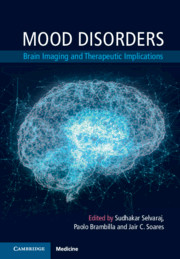Book contents
- Mood Disorders
- Mood Disorders
- Copyright page
- Contents
- Contributors
- Preface
- Section 1 General
- Section 2 Anatomical Studies
- Section 3 Functional and Neurochemical Brain Studies
- Chapter 5 Brain Imaging of Reward Dysfunction in Unipolar and Bipolar Disorders
- Chapter 6 Resting-State Functional Connectivity in Unipolar Depression
- Chapter 7 Functional Connectome in Bipolar Disorder
- Chapter 8 Magnetic Resonance Spectroscopy Investigations of Bioenergy and Mitochondrial Function in Mood Disorders
- Chapter 9 Imaging Glutamatergic and GABAergic Abnormalities in Mood Disorders
- Chapter 10 Neuroimaging Brain Inflammation in Mood Disorders
- Section 4 Novel Approaches in Brain Imaging
- Section 5 Therapeutic Applications of Neuroimaging in Mood Disorders
- Index
- Plate Section (PDF Only)
- References
Chapter 9 - Imaging Glutamatergic and GABAergic Abnormalities in Mood Disorders
from Section 3 - Functional and Neurochemical Brain Studies
Published online by Cambridge University Press: 12 January 2021
- Mood Disorders
- Mood Disorders
- Copyright page
- Contents
- Contributors
- Preface
- Section 1 General
- Section 2 Anatomical Studies
- Section 3 Functional and Neurochemical Brain Studies
- Chapter 5 Brain Imaging of Reward Dysfunction in Unipolar and Bipolar Disorders
- Chapter 6 Resting-State Functional Connectivity in Unipolar Depression
- Chapter 7 Functional Connectome in Bipolar Disorder
- Chapter 8 Magnetic Resonance Spectroscopy Investigations of Bioenergy and Mitochondrial Function in Mood Disorders
- Chapter 9 Imaging Glutamatergic and GABAergic Abnormalities in Mood Disorders
- Chapter 10 Neuroimaging Brain Inflammation in Mood Disorders
- Section 4 Novel Approaches in Brain Imaging
- Section 5 Therapeutic Applications of Neuroimaging in Mood Disorders
- Index
- Plate Section (PDF Only)
- References
Summary
Glutamate (Glu) and gamma-aminobutyric acid (GABA) are the main brain excitatory and inhibitory neurotransmitters. These neurotransmitters are involved in neural migration, differentiation, and synaptic plasticity (1–6). There are accumulating evidence in literature that the neurobiology of mood disorders may arise from an imbalance between excitatory Glu (7–11) and inhibitory GABA (12–15) in key brain regions involved in mood regulation, such as the anterior cingulate cortex (ACC).
- Type
- Chapter
- Information
- Mood DisordersBrain Imaging and Therapeutic Implications, pp. 105 - 120Publisher: Cambridge University PressPrint publication year: 2021

